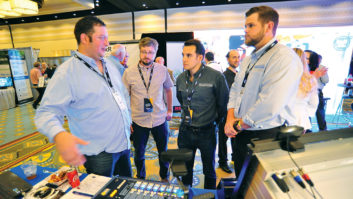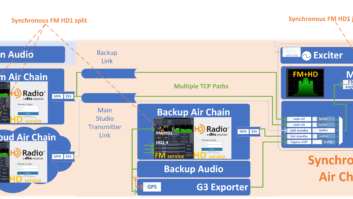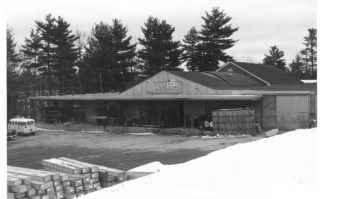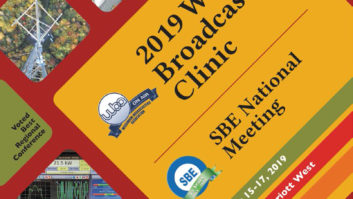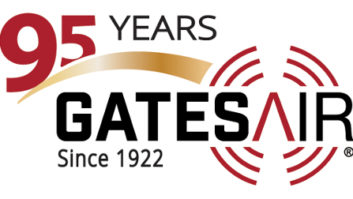
The NAB engineering sessions on Tuesday April 13 will offer a sampling of new technologies that are being developed for radio. In the morning, focus will be on “Radio Data Services” covering topics related to RDS, HD Radio and other technologies to deliver more content and applications to receivers. The session chair is Dom Bordonaro of Cox Radio.
Tuesday morning’s presentations start with Mike Starling, NPR’s vice president and chief technology officer and the executive director of its Technical Research Center and NPR Labs.
In “Emerging Bonded Metadata Applications and Accessible Radio Services,” Starling will provide an update of the Technology Research Center’s work on a initiative to support synchronized bonded metadata services, for live and delayed broadcast, in the rollout of the next-generation Public Radio Satellite System (Radio World, March 1).
The TRC is a new service initiative of NPR Distribution, which now houses the NPR Labs operating unit. One of the new bonded metadata applications under development is Captioning for Radio, an emerging digital service feature previously unavailable to analog-only radio.
Papers by individuals involved in employing alert technologies will focus on using RDS/RBDS technology on FM stations.
Matthew Straeb, executive vice president of Global Security Systems, will present “Saving Lives With FM Radio-Based Mass Notification.”
He will discuss how emergency alerts can be done via RBDS, and technologies that can be more granular at assigning alerts than traditional FIPS codes used in EAS broadcasts. Alerts using these types of technology can be assigned to smaller and specific areas, such as a Zip code.
While this technology now requires receivers meant to decode the warning messages, Straeb sees these features integrated into more common devices — specifically the cell phone, should U.S. carriers start including FM radios in their cell phones.
Straeb states that 40 percent of cell phones outside of the United States have integrated FM radios; if that were to be extended inside the United States, it would create a valuable platform for mass notification of alerts to the public. Straeb said many design issues related to the implementation of this technology in cell phones has been achieved.
He adds that some 500 million FM/RBDS chips have been shipped since 2001.
“The Benefits of Using FM RBDS Data in Integrated Public Alert and Warning” is by Bill Marriott, chief technology officer of viaRadio.
While Marriott would like to see implementation in cell phones, he said other issues need to be considered. Phone manufacturers will have to coordinate and agree with the carriers to incorporate these features; he doesn’t foresee that happening quickly. Other items such as giving control over the phones software to a third-party alerting service and even controlling the FM tuner to monitor alerts will be issues to work out. Having the user of the phone listening to an FM station, and having the phone listening for alerts, can present a competing use for the tuner. He feels this will take time to resolve and is instead focusing on devices that are radios, such as a clock radio, with two tuners; one tuner to monitor for alerts, and one for the listener to control.
“No single warning technology is perfect. We need a layered approach.” He thinks FM alerting via RBDS is an important layer in conjunction with EAS, SMS, Reverse 911 and Internet technologies, and that RBDS is the most efficient way to broadcast rapidly to many people. Using New York City as an example, if devices to receive such alerts became ubiquitous, “It’s the fastest way to wake up millions of people.”
Continuing with the RDS/RBDS theme, Jim Roberts, product manager for The Radio Experience at Broadcast Electronics, will present “Do More With RDS Data.”
He will discuss the basics of RDS displays and the use of software to improve the listener experience.
Roberts also will address more advanced RDS concepts such as interleaving messages, linking messages to audio and how to utilize RDS to improve promotions and advertisements.
He’ll also talk about RDS tagging and the implementation of tagging via social networking sites like Twitter and Facebook to make tagging accessible to more listeners without the need for specific mobile devices or special receivers.
“Providing Media-Rich Content Using Digital Radio” will be presented by Tim Anderson, manager of strategic market and product development at Harris Broadcast.
He will discuss new applications for digital radio; the paper will focus on HD Radio technologies and developments, but he said many of these advances apply to international DRM/DAB platforms as well.
Exciting applications such as transmitting graphical slide shows are being developed and could be used for sending station logos, album art, advertisements and weather graphics synchronized to audio content. Other applications include electronic program guide (EPG), 5.1 surround sound, Traffic Message Channel, conditional access and Journaline, a service that provides structured text data to radio receivers to present “magazine content” or news content on the radio display.
Anderson will outline some of the transmission and receiver sub-systems and protocols required to do this as well.
Before lunch, media technology consultant Skip Pizzi will present “Enhanced Radio Broadcasting: Next-Gen Features for Connected Devices.”
Pizzi will share his experiences working on some of these new technologies and provide a status of their development. For instance, the electronic program guide could enhance the listening experience.
“There’s a lot of content on radio that people don’t know about unless they stumble on it,” he said. “This puts terrestrial radio at some sort of parity with other mediums” such as television.
RadioDNS/RadioVIS is another technology he will address; it leverages the power of the Internet for connected radios. New receivers are being designed that not only tune in terrestrial broadcasts but can be connected to a network and have access to the Internet, creating exciting opportunities for the radio to download content and graphics to the display.
Pizzi will also discuss the various types of tagging via RBDS and HD Radio and apps for mobile devices. Afternoon
The afternoon sessions, “Radio Case Studies,” will present a range of topics ranging from non-traditional STLs, interference/noise analysis on the FM band and satellite delivery networks to enhancing digital content on the web, using computer modeling for reradiating structures on AM, and using voice over IP in a broadcast environment. The chair is Andy Laird of Journal Broadcast Group.
The first, “Satellite Distribution of HD Radio and Analog FM Using HDC,” is presented by Mike Pappas, chief engineer of KUVO(FM) in Denver.
For stations that need to deliver STL-quality audio to multiple transmitters across large distances, the costs of data links to these locations can be expensive, especially when you consider HD1/HD2/HD3 streams along with the traditional analog FM audio. Pappas will share his experiences in a project involving a satellite network to deliver audio to two distant sites via satellite using the 300 kbps HDC “HD Radio” audio codec and then deriving the analog FM audio from this stream.
Doing such provides significant savings over the long term when considering two or more stations, and becomes “a cost-effective solution to roll out HD” in those situations, Pappas said.
For shorter distances, Paul Shulins of Greater Media in Boston shares his experiences of using non-traditional point-to-point wireless STLs in his presentation “Maximizing the Reliability of Studio-to-Transmitter Links for Radio.”
When it comes to today’s STL requirements of getting multiple audio sources to a single site, “the old Part 74 stuff isn’t cutting it anymore,” he states. “People need to find new [higher capacity] links.”
While broadcasting solutions that use 2.4 GHz and 5.8 GHz unlicensed spread-spectrum technologies have been popular to deploy and offer a lot more capacity, Shulins said he experienced problems with reliability as these unlicensed bands became saturated.
He will outline his successes and challenges using licensed 11 GHz and 18 GHz links, bands that were traditionally off-limits to broadcasters for STLs due to FCC rules.
“The commission needed to be convinced to allow it… [w]e had to show the need.” The benefits are enormous; licensed, protected channels and transmission rates of 150 megabits (or more) are possible. Shulins will outline the regulatory landscape, technology and some of the theory to consider for these types of links. “This, or something like this, is going to be the future of STLs.”
Steve Johnston of Wisconsin Public Radio will present “Indoor Noise Conditions in the FM Broadcast Band,” sharing his experience of finding devices in homes and businesses that create noise that interferes with FM broadcasts.
“It’s hard to put absolute numbers on this,” he states, but he will present data comparing the FM band inside and outside of homes and offices.
“As soon as you step in the door … the noise floor rises significantly, covering up the weaker signals.” Some of the worst noise polluters include newer TVs and lightweight AC adapters to charge smaller devices like cell phones.
“Due to the relatively low power of HD carriers, this could be partially to blame for the poor indoor HD reception,” he said.

Outdoor and indoor measurements showing noise in the FM band from a presentation by Steve Johnston. “Case Study: PRSS Next-Generation Content Delivery” by Pete Loewenstein, vice president of distribution for NPR, focuses on important upgrades planned for the Public Radio Satellite System, which is used by some 400 NPR and other public stations and serves hundreds more.
New receivers are being tested, with an eventual goal to ship to stations in 2011 and converting to the new system in 2012.
Engineers whose stations use the system may wish to attend as Loewenstein will outline the new features and benefits, an updated timetable for the project and what interconnected stations must do to convert.
A.J. Janitschek of Radio Free Asia will share ideas to improve your on-air and interactive offerings.
In his presentation “Radio Living in a Multimedia World,” he will discuss the use of video and social media by your station’s reporters and personalities to help capture more than audio when they’re at an event or covering a story.
“We are no longer in just the radio business, we’re in the multimedia business,” he said. Radio Free Asia has had success adding such content to its web site and social media sites and YouTube. Including this content on other popular sites has been helpful as the Radio Free Asia site is censored in some nations.
“Detuning in the MoM Era,” presented by John Warner, vice president of AM engineering for Clear Channel, will focus on new rules under consideration by the FCC that would allow other licensees building or making modifications to towers near AM stations to use Method of Moments (MoM) computer modeling to determine if a proposed tower will impact the AM station.
If the MoM analysis shows adverse effects, they can use the computer modeling to determine the detuning solution and impact. This is in contrast to current rules that require field measurements before and after construction. These rules could be enacted as early as this spring.
Warner will cover how to interpret reports that might be served as notification to a station, and what you should do if you get the paperwork. He also will talk about detuning and some of its myths.
“There are a lot of towers that have been detuned that didn’t need to be,” he said. Using MoM should help in understanding the difference between a tower that will affect the entire pattern vs. having just a localized effect on a single area or monitor point.
The presentation “Telephones in Your Studio or Newsroom: Big Changes Coming” is by Joe Talbot, director of engineering of Citadel Broadcasting in San Francisco.
“The handwriting is on the wall. POTS is done,” Talbot says. He will talk about how voice-over-IP technologies can be leveraged in a broadcast environment to reduce costs while improving the quality of the content and making it easier for your operation to use.
“You don’t have to spend much money … to enjoy the benefits of these changes,” he said. “You are no longer tied to a single vendor for everything.” Talbot will share experiences with name-brand and open-source solutions.
And “Power Quality in Communications Facilities” is intended to recommend wiring and grounding techniques and practices that should be part of new or renovated structures.
“We will examine several case histories, including television, radio and 911 communications centers,” stated David Brender, national program manager for the Copper Development Association, in an NAB summary.
“The power quality wiring and grounding practices to help prevent power quality problems from occurring, or diminish their effect, are applicable to every industrial end use.”
Alan Jurison, CSRE, AMD, DRB and CBNT, is a regional IT manager/broadcast engineer for Citadel Broadcasting in Syracuse, N.Y.





